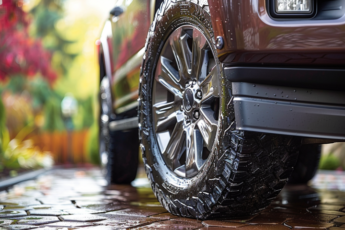Last Updated on 2 weeks
Your Ultimate Guide to Making Informed Tire Purchases
When selecting the best tires for your vehicle, it’s crucial to consider various factors, such as the type of tire, the brand, and your car’s specific needs. Buying tires can seem overwhelming due to the vast range of options available. However, with the correct information and the essential questions to ask, such as the kind of tires needed, expected mileage, cost, and whether to get a replacement set or upgrade, your tire buying experience can be considerably simplified. Reputable resources like Tire Rack’s Tire Decision Guide can assist you in making the perfect tire choice quickly, supported by extensive tire data, including warranties, treadwear guarantees, and test results.
Key Takeaways
- Consider tire type, brand, and specific vehicle requirements
- Utilize reputable resources like Tire Rack’s Tire Decision Guide
- Assess your driving habits, climate, and terrain for optimal tire selection
- Research tire reviews, comparisons, and test results
- Understand tire specifications and performance ratings
- Balance cost and quality when choosing tires
- Practice regular tire maintenance, inspection, and rotation
Understanding Tire Technology: Innovation and History
Tire technology has evolved significantly from the early solid rubber rings to today’s innovative run-flat tires, constructed to remain operational even when punctured. Advances like stiff sidewall run-flats and the Michelin-developed PAX system demonstrate the tire industry’s focus on enhancing durability and performance.
Run-flat tires are equipped with reinforced sidewalls that support the tire even when air pressure is lost due to a puncture, allowing drivers to continue driving for a limited distance at reduced speeds until they can reach a safe location for tire replacement or repair. The table below summarizes the development of tire technology throughout history:
| Period | Technology | Description |
|---|---|---|
| 1800s | Solid rubber | Early tires were made from bands of solid rubber fitted around wagon wheels. |
| 1888 | Pneumatic tires | John Boyd Dunlop invented the first practical pneumatic (air-filled) bicycle tire. |
| 1903 | Cord plies | The introduction of cords made from textile fabric, such as cotton or rayon, improved tire strength and flexibility. |
| 1946 | Radial tires | Michelin introduced the radial tire, which uses cords perpendicular to the bead, offering better tire performance and wear characteristics. |
| 1980s | Run-flat tires | Run-flat technology is introduced, allowing drivers to continue driving for a short distance despite a puncture. |
| 2000 | PAX system | Michelin develops the PAX system, a tire and wheel assembly that offers the benefits of run-flat tires and additional features. |
The PAX system, a comprehensive tire and wheel solution, offers unique benefits such as a lockable bead that secures the tire to the wheel, even when deflated, and allows for repairs under certain conditions, unlike most run-flat designs. This tire innovation ensures excellent safety and convenience for drivers, making it a valuable development in the evolution of tire technology.
Gauging Your Needs: Selecting the Right Tire
Two significant factors should be considered regarding tire selection: the climate and terrain you regularly encounter and your driving habits. These factors help determine the most suitable type of tire to meet your needs in various driving conditions and ensure optimal vehicle performance.
Assessing Terrain and Climate
Selecting the right tire for the specific terrain and climate conditions you experience is essential for safety, comfort, and vehicle performance. For example, drivers with a combination of dry, wet, and snowy conditions may benefit from all-weather tires. These tires offer nearly comparable snow traction to winter tires while retaining the versatility of all-season tires and can be identified by a distinctive snowflake-within-a-mountain symbol.
Pro tip: To further optimize your tire selection based on your region’s climate, consider consulting local automotive experts or online resources like Tire Rack’s Tire Decision Guide, which uses your specific climate and driving expectations to suggest the most suitable options.
Matching Tires to Driving Habits
Your driving habits should also play a significant role in your tire selection. You may prioritize comfort, handling, or appearance based on your vehicle type and desired driving experience.
- High-performance all-season tires: For drivers who prefer a sportier driving experience and prioritize road grip with their vehicles, high-performance all-season tires offer enhanced control and handling, often at the cost of sacrificing some winter capability.
- Grand touring all-season tires: For those seeking a more balanced combination of comfort, appearance, and moderate handling properties, great touring all-season tires present an ideal choice. These tires often feature a lower-profile appearance, designed to complement the aesthetics of various sedans, coupes, and family vehicles.
Ultimately, finding the perfect tire for your vehicle involves taking inventory of your driving habits, terrain type, and climate considerations. Understanding these factors and conducting thorough research on tire options will maximize safety, comfort, and performance.
The Importance of Tire Reviews and Comparisons
When shopping for tires, it is crucial to consult tire reviews and engage in thorough tire comparisons to gain valuable insights into tire performance and longevity. Trustworthy sources that provide information such as treadwear guarantees, warranties, and tire test results are of utmost importance in making informed choices when purchasing tires that suit your vehicle specifications and personal preferences.
Reputable tire testing organizations and publications often undertake comprehensive tests to evaluate critical aspects like wet and dry grip, tread life, ride comfort, and rolling resistance. Analyzing the results from these tests enables potential buyers to confidently select the most suitable tires for their vehicles.
“High-quality tire reviews and comparisons provide invaluable insights into how well a tire performs in varying conditions, enabling drivers to make more informed decisions.”
Furthermore, examining tire comparison studies can help consumers identify top-ranked tires among all-season, winter, and high-performance categories. These rankings often reflect aggregated test results, expert evaluations, and consumer experiences.
- Read multiple tire-review sources: This ensures you gather a varied perspective on the tire’s performance, reliability, and value for money.
- Compare tire-test results: Analyzing results from different tests can reveal the strengths and weaknesses of a particular tire model, facilitating a more confident decision.
- Consult actual consumer experiences: Reading real-world feedback from people who have used the tires you are considering will help validate the findings of professional reviewers.
- Research warranties and treadwear guarantees: Understanding the warranty coverage and treadwear promises will help you determine the long-term value of a tire model.
| Tire Model | Dry Grip | Wet Grip | Tread Life | Ride Comfort | Rolling Resistance |
|---|---|---|---|---|---|
| Tire A | 9 | 7 | 8 | 8 | 8 |
| Tire B | 8 | 9 | 7 | 7 | 6 |
| Tire C | 7 | 8 | 9 | 8 | 9 |
| Tire D | 7 | 7 | 6 | 9 | 8 |
In conclusion, do not underestimate the importance of tire reviews and comparisons when selecting a new set of tires. Utilizing information from verified sources, test results, and real-world consumer experiences will ultimately lead you to the correct set of tires for your vehicle and driving preferences.
Where to Buy Tires: Online Shopping vs In-Person

When purchasing tires, consumers often face the dilemma of choosing between online tire shopping and buying from local tire retailers. Both options have unique advantages and considerations, which are discussed below.
Online Tire Shopping Perks
Online tire shopping has been gaining popularity due to its numerous consumer benefits. Some of the most significant advantages of online tire shopping include:
- Convenience: Online shopping allows you to compare tire deals, read reviews, and purchase from the comfort of your home.
- Wide selection: Online retailers often offer a broader range of tire brands and models than brick-and-mortar stores.
- Competitive pricing: Websites may provide better tire deals, helping you save on your tire purchase.
- Access to detailed information: Online platforms often provide comprehensive tire information, including tire warranties, treadwear guarantees, and test results.
Platforms like Giga-Tires.com allow you to access valuable tire information and find suitable tire deals to meet your needs.
Finding Trusted Local Tire Retailers
While online tire shopping has undeniable perks, considering trusted local tire retailers should not be overlooked. These retailers can offer benefits unavailable through online platforms:
- Face-to-face customer service: Local retailers provide personalized service and immediate support, enhancing your tire purchasing experience.
- Physical inspection of tires: Examining tires in person before buying adds more assurance to your decision.
- Installation and maintenance: Most local retailers offer tire installation services and can provide ongoing care, ensuring the longevity of your investment.
- Immediate availability: In urgent situations, buying from a local retailer allows for quicker assessment and fulfillment of your needs.
In conclusion, choosing between online tire shopping and local tire retailers depends on your preference for convenience, immediate service, and the level of personal interaction you desire during the tire buying process. By weighing the pros and cons of each option, you can make the best decision for your tire purchase and enjoy an optimal customer service experience.
Decoding Tire Specs: Size, Type, and Performance Ratings
Understanding tire specifications is crucial for making an informed purchase. Key aspects include tire width, aspect ratio, load rating, speed rating, and overall performance potential, all indicated on the tire’s sidewall and should align with the vehicle manufacturer’s recommendations for maintaining safety and optimal performance.
Let’s take a closer look at these essential tire specs:
- Tire Width: The first three-digit number on a tire’s sidewall represents its width in millimeters. Wider tires typically provide better traction and handling, while narrower tires may provide better fuel efficiency and ride comfort.
- Aspect Ratio: The following two-digit number corresponds to the tire’s height-to-width ratio, representing a percentage. A lower aspect ratio generally leads to a sportier ride, while a higher ratio offers a smoother and more comfortable experience.
- Load Rating: The numerical code that follows the tire size indicates the tire’s maximum load capacity. Ensure the load rating of your new tires matches or exceeds the recommended rating for your vehicle to ensure safety and performance.
- Speed Rating: The final letter in the series represents the tire’s maximum speed capability. This rating is established by testing the tire at predetermined speeds and temperatures. Always choose tires with a speed rating that meets or exceeds your vehicle’s requirements.
Example: A tire marked 205/55R16 94V has a width of 205mm, an aspect ratio of 55%, a load rating of 94, and a speed rating of V (up to 149 mph).
In addition to these specifications, understanding performance ratings can help you make an informed decision when selecting tires. Various tests are conducted to assess handling, comfort, noise levels, wet and dry grip, and other aspects of a tire’s performance. These tests provide valuable insights into a tire’s overall performance potential. The following table demonstrates some standard performance ratings:
| Performance Rating | Description |
|---|---|
| Wet Traction | Measures the tire’s grip on wet roads, helping to predict its ability to maintain control during wet conditions. |
| Dry Traction | Evaluates the tire’s grip on dry pavement, which is crucial for handling and cornering capabilities. |
| Ride Comfort | Assesses the tire’s ability to absorb road imperfections and vibrations, contributing to a smoother and more comfortable driving experience. |
| Noise Level | Measures the amount of noise the tire generates while driving, impacting overall comfort and enjoyment. |
Considering your vehicle’s recommended tire size and the load and speed ratings alongside performance ratings will ensure you make a well-informed decision that leads to optimal safety and driving experience.
Considering Budget: Balancing Cost and Quality

Finding affordable tires while maintaining the desired quality is crucial for most consumers. Tire prices can vary depending on the brand, type, and warranty offered. To ensure you make a wise investment, it’s essential to consider both the upfront costs and the long-term value of the tires.
Researching tire treadwear and mileage warranties can provide valuable information for estimating long-term value. Additionally, it’s essential to balance cost and quality while selecting the best tires to fit your budget and meet your vehicle’s performance and safety requirements.
Opt for the best tire quality that fits within your budget to ensure safety and long-term vehicle performance.
To aid in your tire purchasing decision, we’ve compiled a list of factors to consider:
- Prioritize reputable tire brands with a proven track record
- Research tire treadwear and mileage warranties
- Evaluate customer reviews and professional test results
- Utilize online resources to compare tire prices
Knowing the ongoing costs associated with tire maintenance, including rotations and alignments, is also helpful. Factor these costs into your budget to ensure you make a well-rounded decision.
| Factors | Examples |
|---|---|
| Reputable Brands | Michelin, Goodyear, Continental |
| Tire Treadwear | Uniform Tire Quality Grading (UTQG) system, Treadwear rating |
| Mileage Warranties | 50,000-mile, 60,000-mile, 80,000-mile warranties |
| Online Resources | Tires-easy.com, Giga-tires.com, Tires-easy-truck.com |
In conclusion, the cost-quality balance is vital to the tire-buying process. By carefully considering factors like brand reputation, treadwear ratings, and mileage warranties, you can find affordable tires that fit your budget without compromising quality or safety.
Maximizing Tire Longevity: Maintenance and Care Tips
Regular tire maintenance is critical to preserving tire longevity. Adopting optimal practices such as thorough inspections, periodic tire rotation, and understanding of tire tread life can significantly extend the life of your tires while ensuring consistent vehicle handling and performance.
Regular Inspection and Tire Rotation
Inspecting your tires monthly for signs of wear, damage, or under-inflation can help identify potential problems before they escalate. Checking for physical deformities, such as bulges, and ensuring proper inflation levels are critical aspects of a dedicated inspection routine.
Tire rotation is another essential step to maximizing tire longevity. By rotating your tires every 5,000 to 8,000 miles, depending on the manufacturer’s recommendation, you can ensure even wear and extend the life of your tire set. The table below presents a typical tire rotation pattern:
| Tire Position | Destination |
|---|---|
| Front Left | Rear Right |
| Front Right | Rear Left |
| Rear Left | Front Right |
| Rear Right | Front Left |
Understanding Tread Life and Replacement Cycles
Tread life is a crucial factor in tire maintenance and replacement. Being aware of your tires’ treadwear rating and comparing it to their actual wear can help you determine the optimal time for tire replacement. This can ensure consistent traction and performance while avoiding premature tire changes.
“The penny test is a simple way to check if your tires have enough tread depth. Place a penny into the tread with Lincoln’s head upside down. If the top of Lincoln’s head is visible, your tires may need replacement.”
In addition to the penny test, frequently monitoring tire wear can provide valuable insights into your tire’s performance and maintenance requirements. For optimal safety, follow the manufacturer’s recommendations regarding tire replacement intervals, and always act promptly if you notice irregular wear or performance issues.
- Check tire inflation levels and conditions every month.
- Rotate tires according to the manufacturer’s recommendation.
- Monitor tread life and replace tires following the manufacturer’s guidelines.
- Address any performance or handling issues promptly.
By adopting these maintenance tips, you can extend the life of your tires, enhance your vehicle’s performance and safety, and ultimately save money in the long run.
Conclusion
As explored in this guide, finding the best tires to buy involves thoroughly understanding tire technology, assessing individual needs, and thorough research. It’s crucial to stay informed about the latest innovations in the tire industry, such as run-flat tires and the Michelin PAX system, to make informed decisions when purchasing.
Evaluating terrain, climate, and driving habits is essential for selecting top-rated tires that ensure safety and enhance your vehicle’s performance and longevity. Additionally, leveraging tire reviews, comparisons, and understanding tire specifications can help identify reliable tire brands that cater to your specific requirements and budget.
Investing time in research, consulting reputable sources, and considering factors like tire technology, climate, driving habits, and maintenance will lead you to the optimal tire purchase decision. By following the steps and tips outlined in this article, you will be well on your way to finding the perfect tires that enhance your driving experience and provide long-lasting value for your vehicle.
FAQ
What factors should I consider when buying tires?
When selecting tires, consider factors such as brands, tire types, specific needs for your vehicle, expected mileage, cost, and whether to get a replacement set or upgrade. It would be best to account for the climate and terrain you regularly encounter.
How has tire technology evolved?
Tire technology has advanced significantly, from early solid rubber rings to today’s innovative run-flat tires. Examples include stiff sidewall run-flat tires and the Michelin-developed PAX system, which focuses on enhancing durability and performance.
How do I select the right tire based on my driving habits and the environment?
Matching your tire selection to your driving habits, climate, and terrain is essential. High-performance all-season tires are ideal for sportier driving styles, while grand touring all-season tires offer a balance of comfort, appearance, and moderate handling capabilities.
Why are tire reviews and comparisons critical?
Tire reviews and comparisons provide essential information about the performance and longevity of different tire models. Information like treadwear guarantees, warranties, and test results from verified sources can help you choose the best tires for your vehicle and personal preferences.
What are the benefits of shopping for tires online vs. buying them in person from local retailers?
Online tire shopping offers convenience, easy comparison, and access to a broader range of products. Local retailers provide personalized service, instant support, and immediate availability of products that may not be as readily accessible when shopping online.
How can I understand tire specifications to make an informed purchase?
Familiarize yourself with tire specifications, such as tire width, aspect ratio, load rating, speed rating, and overall performance potential. These specifications are indicated on the tire’s sidewall and should align with the manufacturer’s recommendations.
How can I balance cost and quality when purchasing tires?
Research tire treadwear and mileage warranties to balance cost and quality, which help estimate long-term value. Choose the best tire quality within your budget to ensure safety and optimum vehicle performance.
What maintenance and care tips can maximize tire longevity?
Regular tire maintenance, such as inspections and periodic rotations, maximizes tire longevity. Tire rotation helps ensure even wear, prolonging your tires’ life and maintaining consistent vehicle handling.










